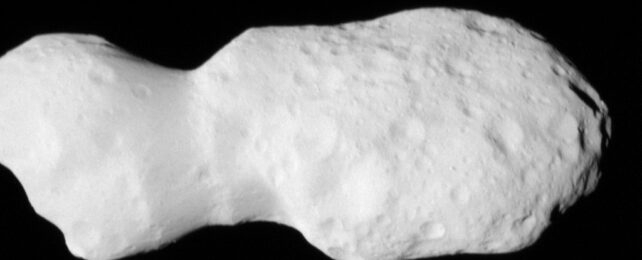NASA's Lucy spacecraft made a successful flyby of the second asteroid on its must-see list over the weekend, and sent back imagery documenting the elongated object's bizarre double-lobed shape.
It turns out that asteroid Donaldjohanson – which was named after the anthropologist who discovered the fossils of a human ancestor called Lucy – is what's known as a contact binary, with a couple of ridges in its narrow neck. In today's image advisory, NASA compares the ridged structure to a pair of nested ice cream cones.
"Asteroid Donaldjohanson has strikingly complicated geology," said Hal Levison, a planetary scientist at the Southwest Research Institute who serves as the Lucy mission's principal investigator.
"As we study the complex structures in detail, they will reveal important information about the building blocks and collisional processes that formed the planets in our solar system."
Lucy came as close as 600 miles (960 kilometers) to Donaldjohanson on April 20, snapping images every two seconds or so as it zoomed past. The pictures confirmed the asteroid's status as a contact binary – that is, a compound object formed by the sticky collision of two smaller celestial bodies.
Donaldjohanson is somewhat larger than it was previously thought to be, with a length of about 5 miles (8 kilometers) and a width of 2 miles (3.5 kilometers) at the widest point.
The Easter encounter took place three and a half years after Lucy was launched, and 17 months after the 52-foot-wide probe flew past its first target asteroid, Dinkinesh, and a mini-moon called Selam. Like Donaldjohanson, Selam was found to be a contact binary.
Researchers consider both of Lucy's encounters in the main asteroid belt, which lies between the orbits of Mars and Jupiter, to be mere warmups for the mission's main event: a detailed study of so-called Jupiter Trojan asteroids.
Such asteroids are trapped harmlessly at resonance points in Jupiter's orbit due to the giant planet's gravitational influence. No spacecraft has ever gotten close to a Jupiter Trojan.
Tom Statler, NASA program scientist for the $989 million Lucy mission, said the quality of the early imagery demonstrates the "tremendous capabilities" of Lucy's instruments.
"The potential to really open a new window into the history of our solar system when Lucy gets to the Trojan asteroids is immense," he said.
Over the next few weeks, researchers will retrieve, process and analyze data from Lucy's black-and-white imager as well as its color imager, infrared spectrometer and thermal infrared spectrometer. The spacecraft is scheduled to spend most of this year traveling through the main asteroid belt.
Lucy's first encounter with a Jupiter Trojan asteroid, known as Eurybates, is due to take place in August 2027. Four additional Trojan encounters will follow between 2027 and 2033.
This article was originally published by Universe Today. Read the original article.
